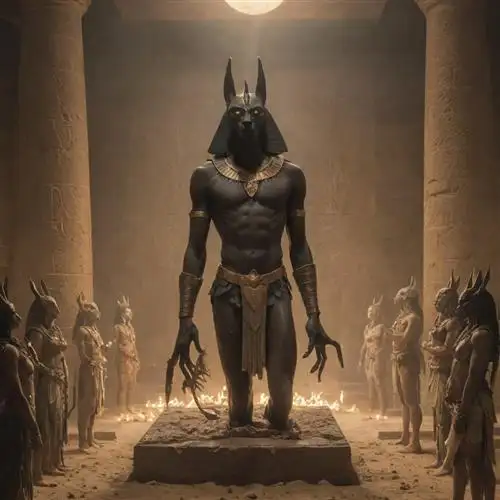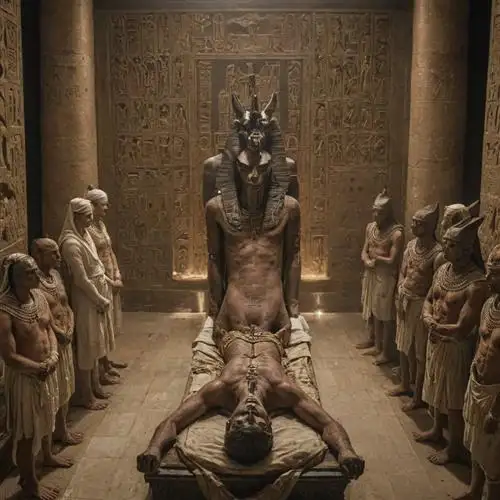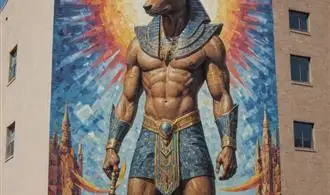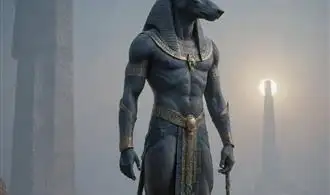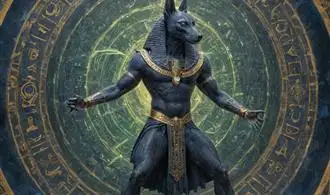
Who is Anubis and His Role in the Afterlife
Anubis, the jackal-headed Egyptian god, played a pivotal role in the ancient civilization's conception of the afterlife. As the god of mummification and the protector of the dead, Anubis was responsible for guiding the souls of the deceased through the treacherous journey to the afterlife.
At the heart of Anubis' role was the process of mummification. It was believed that the preservation of the physical body was crucial for the soul's successful transition to the afterlife. Anubis presided over this meticulous process, ensuring the body was properly prepared and protected. He was often depicted standing over the mummy, guarding and safeguarding the deceased.
But Anubis' influence extended beyond the physical realm. In the judgment of the dead, Anubis played a critical role. The deceased would appear before the tribunal of the gods, where their hearts were weighed against the feather of truth. Anubis was responsible for overseeing this sacred ritual, ensuring the process was carried out with the utmost care and fairness.
If the heart of the deceased was deemed pure and righteous, the soul would be permitted to enter the afterlife and enjoy eternal bliss. However, if the heart was found to be heavy with sin, the soul would be condemned to a fate worse than death. Anubis, in his role as the gatekeeper of the afterlife, was responsible for determining the ultimate fate of the deceased.
Anubis' importance in the Egyptian afterlife was further cemented by his association with the Duat, the mysterious realm of the dead. It was believed that Anubis guided the souls of the deceased through the Duat, navigating the treacherous landscapes and protecting them from the dangers that lurked within.
Anubis and the Weighing of the Heart Ceremony
In the ancient Egyptian pantheon, Anubis stands as a pivotal figure, guiding the dead through the intricate rites of the afterlife. At the heart of this sacred journey lies the Weighing of the Heart ceremony, a profound ritual that determined the fate of the departed soul. As experts delve into the mysteries surrounding this ceremony, they uncover a wealth of insights that shed light on the role of Anubis and the complexities of the Egyptian afterlife.
The Weighing of the Heart ceremony was a critical moment in the journey of the deceased, where the purity of their soul was put to the test. Anubis, the jackal-headed deity, presided over this solemn event, serving as the guardian of the scales and the balance between life and death. The heart of the deceased was placed on one side of the scales, while the feather of Maat, representing truth and justice, was placed on the other.
If the heart was deemed pure, outweighing the feather, the soul was deemed worthy and granted passage to the afterlife. However, if the heart was found wanting, it was devoured by the devouring demon Ammit, a fate worse than death. This ceremony underscores the importance of leading a virtuous life, as the afterlife was dependent on the state of one's soul.
Experts delve deeper into the symbolism and significance of the Weighing of the Heart ceremony, revealing the intricate layers of belief and cosmology that underpinned this ritual. The heart, for instance, was often equated with the seat of the soul, a vital component that carried the weight of one's actions and character. The feather of Maat, on the other hand, represented the principle of universal order and truth, which the deceased had to uphold in life.
Furthermore, the presence of Anubis as the overseer of this ceremony underscores the deity's role as the guide and protector of the dead. Anubis was revered for his ability to navigate the complexities of the afterlife, ensuring the safe passage of the deceased through the trials and tribulations of the underworld.
Symbolism and Significance of Anubis in Ancient Egyptian Culture
Anubis, the jackal-headed deity, held a revered and pivotal role in the intricate tapestry of ancient Egyptian beliefs and practices. As the god of the dead, embalming, and the afterlife, Anubis was a central figure in the complex Egyptian understanding of the journey through death and into the realm of the divine.
The jackal or dog-like appearance of Anubis was not merely a symbolic representation but held deep significance within the Egyptian cosmology. Jackals were often observed lingering near gravesites and were believed to be the guardians of the necropolis, the city of the dead. This association with the liminal space between the living and the dead elevated Anubis to a position of immense importance as the overseer of the delicate transition from this life to the next.
Anubis's role in the embalming process was equally vital. As the deity who presided over the crucial rites of mummification, he was responsible for the meticulous preparation of the deceased, ensuring their safe passage into the afterlife. The embalming process, with its intricate rituals and symbolic gestures, was not merely a practical endeavor but a sacred one, with Anubis as the guiding force.
Beyond his role in the physical realm, Anubis also held sway in the metaphysical and spiritual spheres. He was believed to be the guardian of the Duat, the Egyptian underworld, and the protector of the dead as they navigated the treacherous journey through the afterlife. Anubis was tasked with weighing the heart of the deceased against the feather of truth, determining their worthiness to enter the realm of the gods.
The significance of Anubis extended beyond the realms of the dead, as he was also revered as a deity of protection and guidance. Depictions of Anubis often show him standing vigilantly by the side of the deceased, guiding and guarding them through the perilous passages of the afterlife. This protective aspect of Anubis was highly valued by the ancient Egyptians, who sought his divine intervention in both life and death.
Anubis and the Mummification Process
The role of Anubis in the mummification process was paramount in ancient Egyptian beliefs. As the jackal-headed god associated with embalming and the afterlife, Anubis oversaw the crucial steps involved in preserving the deceased's physical body. The mummification ritual was a complex and meticulous procedure that required great skill and devotion, with Anubis guiding the embalmers every step of the way.
At the heart of the mummification process was the removal of the internal organs, which were deemed necessary for the afterlife. Anubis was believed to personally guide the embalmers as they carefully extracted the organs, cleaned them, and placed them in canopic jars. This was a delicate task, as the organs had to be preserved with great care to ensure the deceased's successful transition to the next world.
Once the internal organs were removed, Anubis oversaw the drying and preservation of the body. This was achieved through the use of natron, a naturally occurring salt that drew the moisture out of the body, effectively mummifying it. The embalmers would then wrap the body in linen bandages, a process that Anubis was said to have personally supervised to ensure the proper protection of the deceased.
Anubis also played a crucial role in the final stages of the mummification process, where the mummy was adorned with various amulets and talismans. These items were believed to provide spiritual protection and guidance for the deceased in the afterlife. As the god of the dead, Anubis was responsible for ensuring that the mummy was prepared and equipped for the journey to the afterlife.
Modern Interpretations and Representations of Anubis
Anubis, the ancient Egyptian god associated with the afterlife, has captivated the minds of both scholars and the general public for centuries. In the modern era, the representations and interpretations of this enigmatic deity have evolved, reflecting the changing perceptions and understandings of this complex figure. Let's explore the secrets that the experts have uncovered about Anubis and the afterlife, with a particular focus on the modern interpretations and representations of this iconic Egyptian deity.
One of the most significant developments in the modern understanding of Anubis is the recognition of his multifaceted nature. Scholars have delved deeper into the god's various roles and responsibilities, revealing a more nuanced and comprehensive picture of his significance in the ancient Egyptian pantheon. Anubis was not merely the god of embalming and the dead, but also a complex figure associated with transition, transformation, and the guardianship of the afterlife.
In the modern context, Anubis has been the subject of renewed artistic and cultural interest. Contemporary artists have reimagined the god's iconography, creating striking visual representations that blend traditional Egyptian motifs with modern sensibilities. These interpretations have not only captivated audiences but also sparked deeper conversations about the enduring relevance of Anubis in the 21st century.
Furthermore, the popularity of ancient Egyptian mythology and culture in popular media has contributed to the widespread recognition and familiarity of Anubis. From blockbuster films to critically acclaimed television series, the god's image and symbolic importance have been amplified, reaching a broader audience and sparking a renewed fascination with the ancient Egyptian afterlife.
Interestingly, the modern exploration of Anubis has also delved into the realm of occult and esoteric studies. Some modern practitioners of Egyptology-inspired spirituality have incorporated Anubis into their rituals and belief systems, drawing upon the god's associations with death, the underworld, and the transition between the physical and spiritual realms.


